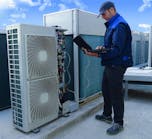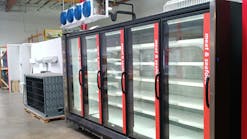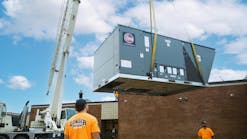We are all trying to increase efficiency in our everyday busy lives with the single purpose of accomplishing more in less time. More and more we hear about “Internet of Things” and how it can improve efficiency. Our access to information is tremendous thanks to IoT and we can produce work and make quick decisions based on research that is found through computer technology, whether from articles, reviews, a variety of websites, data, metrics, and more.
When it comes to commercial, institutional and industrial facilities, we see IoT as a “must have.” Building management systems can “manage and oversee” system start/stop times, optimization, system efficiency, utility consumption, alarms and trouble areas, etc. which can enable a facility manager to make smart, informed decisions. The alarm features can also help prevent catastrophic disaster which could be expensive and inconvenient to remediate.
IoT an Investment in Future Possibilities
Recently, we completed a building management system retrofit in a local art museum. The purpose was to enhance environmental control, provide remote communication capabilities and configure alarms and temperature/humidity trending data so the museum could get better quality artwork to put on display. The museum viewed the upgrade as an investment in their business model, hoping the upgraded artwork would attract more visitors and increase support for their mission.
Of course, implementing these systems comes at a cost but it’s important to think about the future when considering an investment into IoT. Connecting a building to technology is a long-term investment that will pay for itself over time, just based on the intelligence it provides to help guide decisions and/or prevent downtime. A way to start small with IoT would be to retrofit older electro-mechanical equipment with a Wifi thermostat and some sensors. This can be an affordable way to monitor simple things and be able to remotely communicate with equipment.
Connecting a building to technology is a long-term investment that will pay for itself over time, just based on the intelligence it provides to help guide decisions and/or prevent downtime.
There are several available platforms to connect a building system. Alarm features, remote communication, start/stop, temperature control, etc. are available for any existing system. Newer HVAC equipment is being manufactured with factory furnished micro-processors that are usually able to communicate with several building management systems, thanks to improved open protocol and sophisticated translators. Some of the larger manufacturer’s offer equipment with factory controls that “plug and play” with building-wide building management systems that make installation, start-up and commissioning straight forward and easy. In addition, these building based systems can be expanded to control ancillary equipment such as lighting, building access control, security cameras, automatic window shades, and more.
Training to Maximize Potential
When it comes to training, every system has a learning curve. There are “open systems” and “proprietary systems.” The open systems are usually easier to get trained on since they are available to the entire HVAC market.
The proprietary systems are generally manufacturer specific and may require training/certification and a partnership agreement to be qualified and supported as an installer/servicer. Whether it is classroom, wholesaler level, manufacturer, webinar, YouTube, or other program, training is important and valuable to the technicians, salespeople, system designers and operators to maximize the potential of the system being implemented.
At the end of the day, it is about maximizing your ROI. Modern facilities with innovative building management solutions that run efficiently will have a competitive edge that tenants, prospective investors and owners will want to occupy or have in their portfolio. Making a building more intelligent and efficient has turned into a profit center for many building owners. The building that becomes less expensive and hassle free to operate, while being upgraded to modern day convenience, allows the property to become more desirable to potential tenants.
Bud Hammer is President, Atlantic Westchester, Inc., a commercial and industrial HVAC and energy efficiency company located in Bedford Hills, NY. Atlantic Westchester offers a variety of commercial and industrial HVAC solutions for businesses, institutions and government facilities across the NY metro area. For additional information, visit atlanticwestchester.com.









